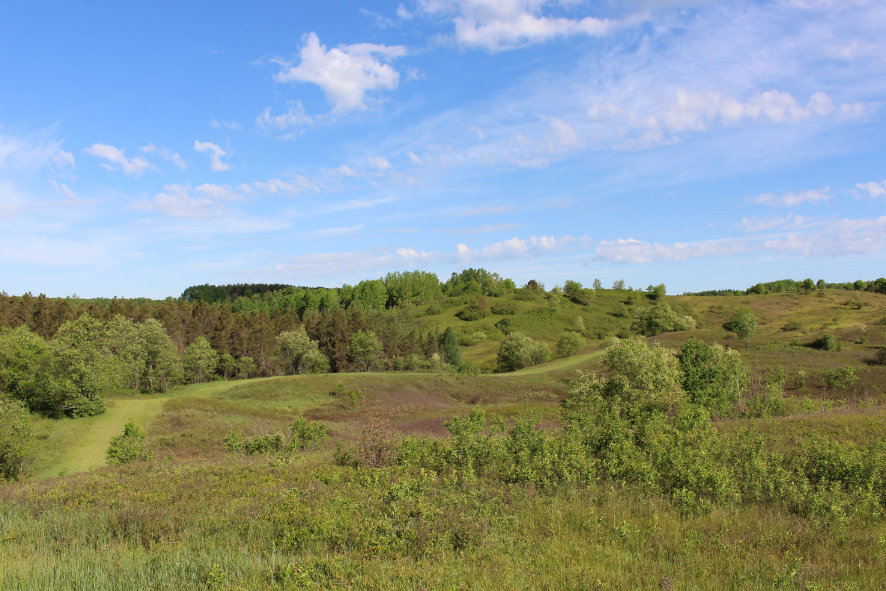
Spread Eagle Barrens State Natural Area. Photo by Caitlin Williamson
Frost in summer, lichen-eating flying squirrels, and a globally rare landscape
When people think of Wisconsin’s Northwoods, they often picture dense forests of pine, aspen, oak, and maple trees. In fact, that’s a pretty clear sign that you’ve entered the Northwoods when making the drive up the state. But hidden within the northern part of the state is over 8,400 acres of wide-open landscape, with six different natural communities.
Located in Florence County, Spread Eagle Barrens State Natural Area encompasses globally rare pine barrens, grasslands, wetlands, and woodlands. The Pine River, a federally designated Wild River, bisects the property. Additionally, the Menominee River runs along the eastern boundary.
Frost pockets (treeless depressions where frost can occur at any time of the year) are found throughout the site. Lichen, which dominate the low-lying areas, are a main food source for the northern flying squirrel, a species of special concern in Wisconsin.
Spread Eagle Barrens is considered one of Wisconsin’s most ecologically important sites and is jointly owned by the Wisconsin Department of Natural Resources and We Energies. The landscape features scattered jack and red pine, scrub oak, quaking aspen, clear lakes, and globally imperiled pine barrens.
Once one of the most common habitats in Wisconsin, only 1% of barrens remain in the state.
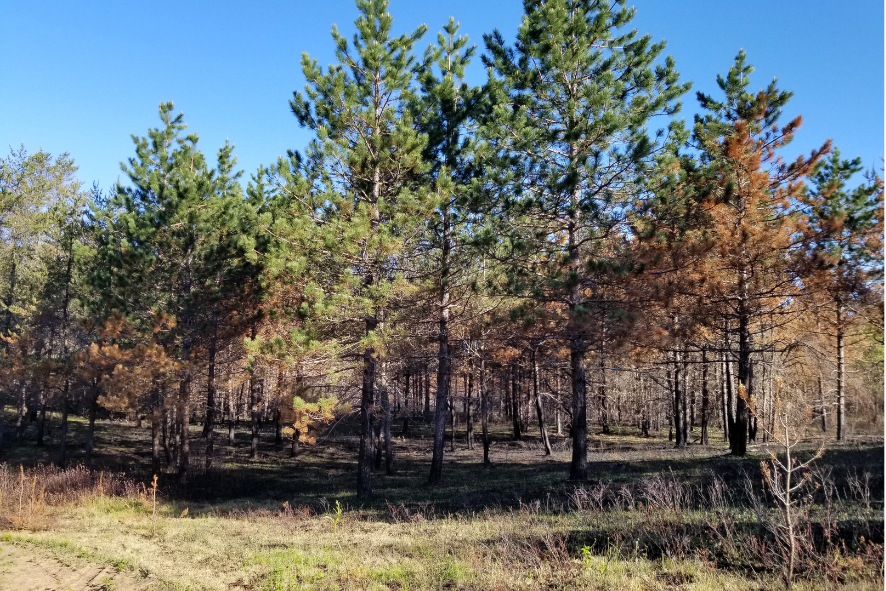
Thanks to a 2022 gift from the We Energies Foundation, Wisconsin DNR State Natural Area crews worked to control woody vegetation and increase prescribed burning at Spread Eagle Barrens State Natural Area. This photo shows the Eagles Nest burn unit following a June 2022 prescribed burn. Photo by Carly Lapin, WDNR
NRF’s support of Spread Eagle Barrens
Thanks to NRF’s donors and the We Energies Foundation, we’ve funded the restoration work at Spread Eagle Barrens since 2007. Together, we are working to improve the health of native plant communities and increase populations of threatened, endangered, and species of greatest conservation need at this ecologically important site. Restoring Spread Eagle Barrens means restoring Wisconsin’s historical ecological communities and rarest species.
*Field Trip participants! Be on the lookout for Carly Lapin’s ‘Spread Eagle Barrens SNA: Barrens & Birding’ NRF Field Trip next summer. Participants hike and explore barrens ecology, broad vistas, interesting plants, and also search for rare barrens birds.
Rare wildlife to spot at Spread Eagle Barrens
Because of its wide-open landscapes, very specific grassland species of plants and animals call Spread Eagle Barrens home. It is a designated national Important Bird Area and protects many rare and declining species that require large open landscapes, including Species of Greatest Conservation Need. From the upland sandpiper, to the common nighthawk and Missouri rock-cress, a variety of rare species depend on this place. There are at least 28 Species of Greatest Conservation Need that currently call Spread Eagle Barrens home. Here are some of them:
Upland sandpiper
The upland sandpiper is a state threatened grassland bird. They thrive in grasslands and barrens, as well as agricultural pastures. Specifically, upland sandpipers prefer large patches of grassland, making Spread Eagle Barrens an ideal habitat for them. They feed almost entirely on grasshoppers, crickets, and weevils, making them friends to farmers! Sandpipers often migrate to Wisconsin in late spring from South American countries, like Brazil and Argentina. That’s upwards of a 6,000 mile journey!
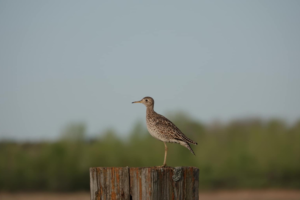
Photo description: An upland sandpiper standing on a wooden stump. Photo by Kari Stauffer
Brewer's blackbird
While common in the western part of the county, the Brewer’s blackbird is a special concern species in Wisconsin. They enjoy open uplands, such as grasslands and meadows, and tend to favor recently burned habitat. You’ll likely spot a Brewer’s blackbird at Spread Eagle Barrens during their breeding season in spring.
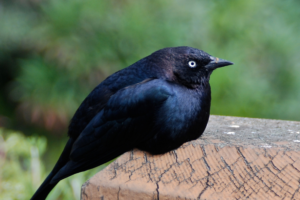
A male Brewer’s blackbird sitting on a fence. Photo by Warren Lynn
Common nighthawk
Despite its name, the common nighthawk is a rare species in Wisconsin. They nest in a variety of habitats, including dry grasslands and barrens, forest clearings, and agricultural fields. Unfortunately, common nighthawk populations have decreased by 60% since the 1960’s due to habitat loss and fragmentation and pesticide use.
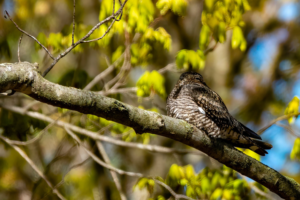
Photo description: A common nighthawk sitting in a tree. Photo by Andrew Holman
Prescribed burning strengthens both Spread Eagle Barrens and its local community
Fire has fueled landscapes since time immemorial. For the past 50 years, it has been a crucial land management tool at Spread Eagle Barrens. Over 2,000 acres of burn units are actively managed throughout the site, all considered early successional habitat. After a disturbance such as prescribed fire, annual plants, grasses, and forb species come back with renewed vigor. Burn units are classified as being in either ‘restoration’ or ‘maintenance’ phases. During the restoration phase, there is more woody vegetation present, so the unit is burned more frequently. A unit in restoration phase is burned every 2 to 7 years. Then, once the woody vegetation has been reduced, the unit enters the maintenance phase and only needs to be burned every 7 to 10 years.
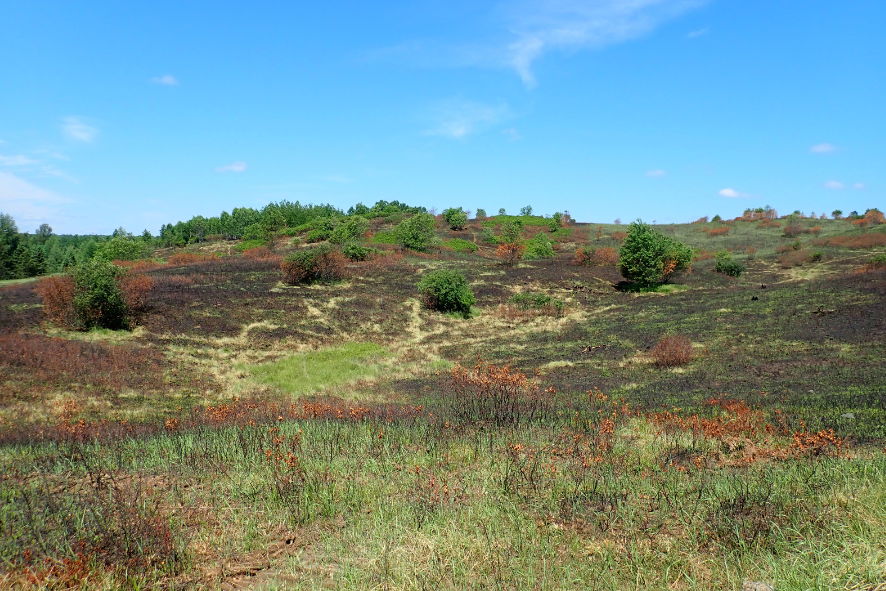
Barrens habitat after a prescribed burn. Photo by Carly Lapin, WDNR
Carly Lapin, DNR ecologist and property manager for Spread Eagle Barrens, explains that one of the challenges is monitoring burn phases due to the size of each unit. The average burn unit size is 100 acres and can be difficult to walk through. So, the project team has been exploring different monitoring tools, such as walking transects and aerial photography.
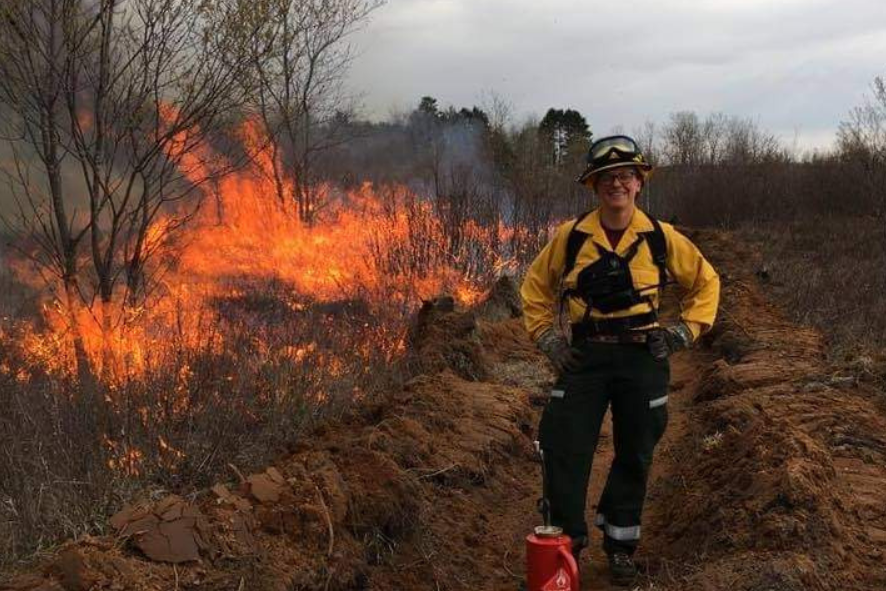
Carly Lapin, in fire gear, standing next to a prescribed burn at Spread Eagle State Natural Area. Photo by Liz Wood, WDNR
Carly says that prescribed burning is “one of the most useful and ecologically-aligned management practices that we can do.” Also, Carly believes that prescribed burning is an underutilized tool. “Most of our state has fire dependent natural communities and what we are burning every year is a pretty minuscule amount of the habitat that could be maintained with fire.”
Members of the local community in Florence County support the use of prescribed burning and are already able to see the positive impacts it has had on the landscape. Birders love to visit Spread Eagle Barrens in hopes of seeing the upland sandpiper. Hunters take advantage of its open landscape. Foragers happily pick berries that respond well to fire.
Connecting with this special piece of public land
Kay Kavanagh started birding after spotting a blackburnian warbler. “I couldn’t believe that I had lived over 40 years and not have known that such a pretty little bird existed,” says Kavanagh. Now, after 50 years of birding in all 72 counties of Wisconsin, Kay is one of our state’s birding greats.
Kay began visiting Spread Eagle Barrens in the early 2000s. “The variety of habitat meant more species of birds,” she notes. There, she has spotted rare birds such as the Connecticut warbler and the prairie warbler. She fondly remembers many canoe trips on the Pine and Menomonie Rivers with her husband, Bob, as well.
Kay’s birding tip: you’ll likely find the most diversity of bird species near Fire Lane Road and Barrens Lake Road. She also recommends Menomonie River Road and Sand Lake Road.
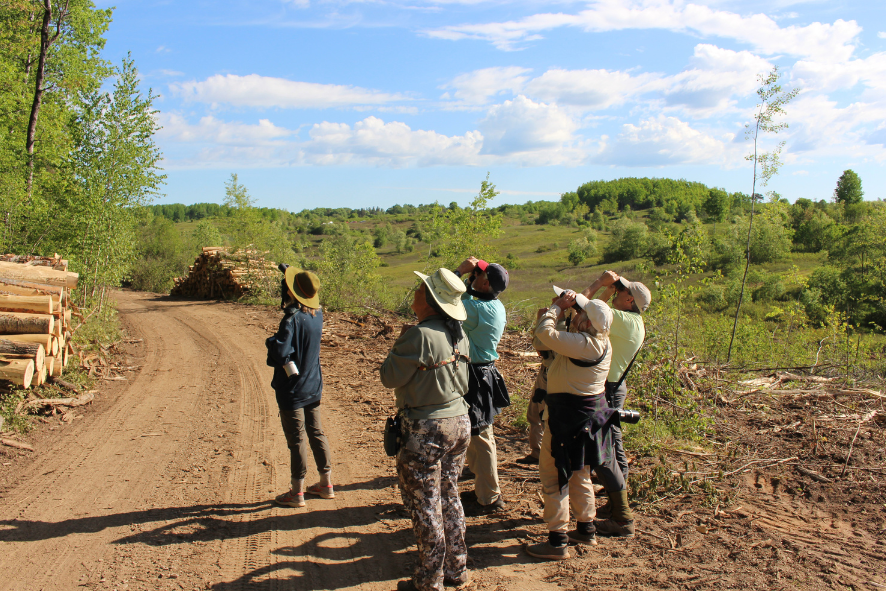
Field Trip participants search for birds at Spread Eagle Barrens State Natural Area. Photo by Caitlin Williamson
Other outdoor recreation at Spread Eagle Barrens includes camping, hiking, and fishing. The fall foliage throughout the landscape is another highlight. In the winter, visitors love to cross-country ski and snowshoe.
Wondering where you should go if you only had time to visit one section of this expansive SNA? Well, Carly’s favorite spot is the LePage Creek overlook, just south of Lake Anna Road.
While reflecting on the importance of protecting Spread Eagle Barrens, Carly shared, “Wisconsinites are so fortunate that we have so much public land and cool places to visit. If people like having that, and like that accessibility, they should continue to support DNR and support our other public land entities, and the maintenance of those available public habitats and public lands.”
The Natural Resources Foundation of Wisconsin funds projects that have a significant and positive impact on Wisconsin’s lands, waters, and wildlife, and that connect people to Wisconsin’s natural wonders.